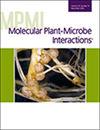求助PDF
{"title":"Visualizing Tomato Spotted Wilt Virus Protein Localization: Cross-Kingdom Comparisons of Protein-Protein Interactions.","authors":"K M Martin, Y Chen, M A Mayfield, M Montero-Astúa, A E Whitfield","doi":"10.1094/MPMI-09-24-0108-R","DOIUrl":null,"url":null,"abstract":"<p><p>Tomato spotted wilt virus (TSWV) is an orthotospovirus that infects both plants and insect vectors, and understanding its protein localization and interactions is crucial for unraveling the infection cycle and host-virus interactions. We investigated and compared the localization of TSWV proteins. The localization between plant and insect cells was overall consistent, indicating a similar mechanism is utilized by the virus in both types of cells. However, a change in localization over time was associated with the viral proteins that did not contain signal peptides and transmembrane domains such as N, NSs, and NSm, which only occurred in the plant cells and not in the insect cells. We also tested the localization of the proteins during an active plant infection using free red fluorescent protein (RFP) as a marker to highlight the nucleus and cytoplasm. Voids in the cytoplasm were shown only during infection, and N, NSs, NSm, and to a lesser extent G<sub>N</sub> and G<sub>C</sub> were surrounding these areas, suggesting it may be a site of replication or morphogenesis. Furthermore, we tested the interactions of viral proteins using both bimolecular fluorescence complementation (BiFC) and membrane-based yeast two-hybrid (MbY2H) assays. These revealed self-interactions of NSm, N, G<sub>N</sub>, G<sub>C</sub>, and NSs. We also identified interactions between different TSWV proteins, indicating their possible roles, such as between NSs and G<sub>C</sub> and N and G<sub>C</sub>, which may be necessary during the replication and assembly processes, respectively. This research expands our knowledge of TSWV infection and elaborates on the intricate relationships between viral proteins, cellular dynamics, and host responses. [Formula: see text] Copyright © 2025 The Author(s). This is an open access article distributed under the CC BY-NC-ND 4.0 International license.</p>","PeriodicalId":19009,"journal":{"name":"Molecular Plant-microbe Interactions","volume":" ","pages":"84-96"},"PeriodicalIF":3.4000,"publicationDate":"2025-02-01","publicationTypes":"Journal Article","fieldsOfStudy":null,"isOpenAccess":false,"openAccessPdf":"","citationCount":"0","resultStr":null,"platform":"Semanticscholar","paperid":null,"PeriodicalName":"Molecular Plant-microbe Interactions","FirstCategoryId":"99","ListUrlMain":"https://doi.org/10.1094/MPMI-09-24-0108-R","RegionNum":3,"RegionCategory":"生物学","ArticlePicture":[],"TitleCN":null,"AbstractTextCN":null,"PMCID":null,"EPubDate":"2025/1/23 0:00:00","PubModel":"Epub","JCR":"Q2","JCRName":"BIOCHEMISTRY & MOLECULAR BIOLOGY","Score":null,"Total":0}
引用次数: 0
引用
批量引用
Abstract
Tomato spotted wilt virus (TSWV) is an orthotospovirus that infects both plants and insect vectors, and understanding its protein localization and interactions is crucial for unraveling the infection cycle and host-virus interactions. We investigated and compared the localization of TSWV proteins. The localization between plant and insect cells was overall consistent, indicating a similar mechanism is utilized by the virus in both types of cells. However, a change in localization over time was associated with the viral proteins that did not contain signal peptides and transmembrane domains such as N, NSs, and NSm, which only occurred in the plant cells and not in the insect cells. We also tested the localization of the proteins during an active plant infection using free red fluorescent protein (RFP) as a marker to highlight the nucleus and cytoplasm. Voids in the cytoplasm were shown only during infection, and N, NSs, NSm, and to a lesser extent GN and GC were surrounding these areas, suggesting it may be a site of replication or morphogenesis. Furthermore, we tested the interactions of viral proteins using both bimolecular fluorescence complementation (BiFC) and membrane-based yeast two-hybrid (MbY2H) assays. These revealed self-interactions of NSm, N, GN , GC , and NSs. We also identified interactions between different TSWV proteins, indicating their possible roles, such as between NSs and GC and N and GC , which may be necessary during the replication and assembly processes, respectively. This research expands our knowledge of TSWV infection and elaborates on the intricate relationships between viral proteins, cellular dynamics, and host responses. [Formula: see text] Copyright © 2025 The Author(s). This is an open access article distributed under the CC BY-NC-ND 4.0 International license.
番茄斑萎病毒蛋白质定位可视化:蛋白质-蛋白质相互作用的跨域比较。
番茄斑点萎蔫病毒(TSWV)是一种同时感染植物和昆虫载体的直翅目病毒。了解蛋白质的定位和相互作用对于揭示感染周期和宿主与病毒之间的相互作用至关重要。我们研究并比较了 TSWV 蛋白的定位。随着时间的推移,不含信号肽和跨膜结构域(如 N、NSs 和 NSm)的病毒蛋白的定位发生了变化,但这种变化只发生在植物细胞中,而不是昆虫细胞中。植物和昆虫的定位结果是一致的,这表明病毒在这两种细胞中利用了类似的机制。我们还使用游离 RFP 作为标记来突出细胞核和细胞质,测试了在植物感染活跃期蛋白质的定位情况。细胞质中的空隙仅在感染期间才会出现,N、NSs、NSm 以及较小程度上的 GN 和 GC 都围绕在这些区域周围,这表明它们可能是复制或形态发生的场所。此外,我们还利用双分子荧光互补(BiFC)和膜基酵母双杂交(MbY2H)试验检测了病毒蛋白的相互作用。这些方法揭示了 NSm、N、GN、GC 和 NSs 的自我相互作用。我们还发现了不同 TSWV 蛋白之间的相互作用,表明了它们的作用和宿主相互作用,如 NSs 和 GC 之间以及 N 和 GC 之间的相互作用,这可能分别是复制和组装过程中所必需的。这项研究拓展了我们对 TSWV 感染的认识,并阐述了病毒蛋白、细胞动力学和宿主反应之间错综复杂的关系。
本文章由计算机程序翻译,如有差异,请以英文原文为准。

 求助内容:
求助内容: 应助结果提醒方式:
应助结果提醒方式:


